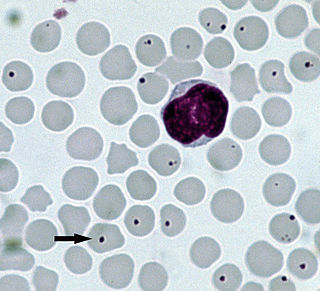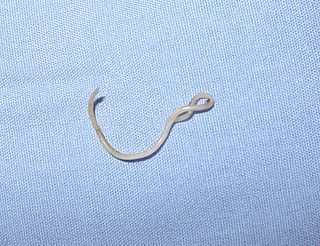
Trichuris trichiura, Trichocephalus trichiuris or whipworm, is a parasitic roundworm that causes trichuriasis when it infects a human large intestine. It is commonly known as the whipworm which refers to the shape of the worm; it looks like a whip with wider "handles" at the posterior end.

Trichuriasis, also known as whipworm infection, is an infection by the parasitic worm Trichuris trichiura (whipworm). If infection is only with a few worms, there are often no symptoms. In those who are infected with many worms, there may be abdominal pain, tiredness and diarrhea. The diarrhea sometimes contains blood. Infections in children may cause poor intellectual and physical development. Low red blood cell levels may occur due to loss of blood.
Paratuberculosis is a contagious, chronic and sometimes fatal infection that primarily affects the small intestine of ruminants. It is caused by the bacterium Mycobacterium avium subspecies paratuberculosis. Infections normally affect ruminants, but have also been seen in a variety of nonruminant species, including rabbits, foxes, and birds. Horses, dogs, and nonhuman primates have been infected experimentally. Paratuberculosis is found worldwide, with some states in Australia being the only areas proven to be free of the disease. At least in Canada, the signs of BJD usually start when cattle are four to seven years of age, and then usually only are diagnosed in one animal at a time. Cattle "with signs of Johne’s disease shed billions of bacteria through their manure and serve as a major source of infection for future calves."

Ascaris suum, also known as the large roundworm of pig, is a parasitic nematode that causes ascariasis in pigs. While roundworms in pigs and humans are today considered as two species with different hosts, cross-infection between humans and pigs is possible; some researchers have thus argued they are the same species. Ascariasis is associated with contact to pigs and pig manure in Denmark.

Paragonimiasis is a food-borne parasitic infection caused by the lung fluke, most commonly Paragonimus westermani. It infects an estimated 22 million people yearly worldwide. It is particularly common in East Asia. More than 30 species of trematodes (flukes) of the genus Paragonimus have been reported; among the more than 10 species reported to infect humans, and only 8 bringing about infections in humans, the most common is P. westermani, the oriental lung fluke.

Canine parvovirus is a contagious virus mainly affecting dogs. CPV is highly contagious and is spread from dog to dog by direct or indirect contact with their feces. Vaccines can prevent this infection, but mortality can reach 91% in untreated cases. Treatment often involves veterinary hospitalization. Canine parvovirus often infects other mammals including foxes, wolves, cats, and skunks. Felines are also susceptible to panleukopenia, a different strain of parvovirus.

Dictyocaulus is a genus of nematode parasites of the bronchial tree of horses, sheep, goats, deer, and cattle. Dictyocaulus arnfieldi is the lungworm of horses, and Dictyocaulus viviparus is the lungworm affecting ruminants.
The soil-transmitted helminths are a group of intestinal parasites belonging to the phylum Nematoda that are transmitted primarily through contaminated soil. They are so called because they have a direct life cycle which requires no intermediate hosts or vectors, and the parasitic infection occurs through faecal contamination of soil, foodstuffs and water supplies. The adult forms are essentially parasites of humans, causing soil-transmitted helminthiasis (STH), but also infect domesticated mammals. The juveniles are the infective forms and they undergo tissue-migratory stages during which they invade vital organs such as lungs and liver. Thus the disease manifestations can be both local and systemic. The geohelminths together present an enormous infection burden on humanity, amounting to 135,000 deaths every year, and persistent infection of more than two billion people.

Anaplasmosis is a tick-borne disease affecting ruminants, dogs, and horses, and is caused by Anaplasma bacteria. Anaplasmosis is an infectious but not contagious disease. Anaplasmosis can be transmitted through mechanical and biological vector processes. Anaplasmosis can also be referred to as "yellow bag" or "yellow fever" because the infected animal can develop a jaundiced look. Other signs of infection include weight loss, diarrhea, paleness of the skin, aggressive behavior, and high fever.

Trichuris, often referred to as whipworms, is a genus of parasitic worms from the roundworm family Trichuridae, which are helminths. The name whipworm refers to the shape of the worm; they look like whips with wider "handles" at the posterior end. The name Trichocephalus is sometimes used for this genus.
Mycoplasma ovipneumoniae is a species of Mycoplasma bacteria that most commonly inhabits and affects ovine animals. M. ovipneumoniae is a respiratory pathogen of domestic sheep, domestic goats, bighorn sheep, mountain goats, and other caprinae that can both cause primary atypical pneumonia and also predispose infected animals to secondary pneumonia with other agents, including Mannheimia haemolytica. Several mechanisms are involved in the pathogenicity of M. ovipneumoniae, including altering macrophage activity, adhering to the ruminants' ciliated epithelium via its polysaccharide capsule, inducing the production of autoantibodies to ciliary antigens, and suppressive activity on lymphocytes, all of which are important factors that contribute to the disease in sheep and other small ruminants. The bacterium also has the ability to act as a predisposing factor for other bacterial and viral infections.

Toxocara canis is a worldwide-distributed helminth parasite of dogs and other canids. The name is derived from the Greek word "toxon," meaning bow or quiver, and the Latin word "caro," meaning flesh. They live in the small intestine of the definitive host. In adult dogs, the infection is usually asymptomatic but may be characterized by diarrhea. By contrast, massive infection with Toxocara canis can be fatal in puppies, causing diarrhea, vomiting, an enlarged abdomen, flatulence, and poor growth rate.

Trichuris suis is a whipworm; the variations in thickness of the anterior and posterior segments give the parasite the characteristic "whip-like" appearance. Adult females measure 6 to 8 cm and adult males 3 to 4 cm. T. suis eggs are oval and yellow-brown with bipolar plugs. T. suis is also used in helminthic therapy studies.
Trichuris vulpis is a whipworm that lives in the large intestine of canines in its adult stages. Out of different types of worms, Trichuris vulpis is one of the smaller worms with a size ranging from 30–50 mm in length. As the name suggests, the worm has a whip-like shape with distinct features including a small, narrow anterior head, which is the digestive part of the worm, and a larger posterior tail, which is the reproductive part of the worm. Eggs from T. vulpis are oval shaped with bipolar plugs and contain a thick outer shell. Their sizes range from 72–90 μm in length and 32–40 μm in width. Because of their thick outer shell, T. vulpis eggs are very resistant to environmental extremes such as freezing or hot temperatures, thus allowing for their long viability in the outside world.
Moniezia expansa is commonly known as sheep tapeworm or double-pored ruminant tapeworm. It is a large tapeworm inhabiting the small intestines of ruminants such as sheep, goats and cattle. It has been reported from Peru that pigs are also infected. There is an unusual report of human infection in an Egyptian. It is characterized by unarmed scolex, presence of two sets of reproductive systems in each proglottid, and each proglottid being very short but very broad.
Phaeohyphomycosis is a diverse group of fungal infections, caused by dematiaceous fungi whose morphologic characteristics in tissue include hyphae, yeast-like cells, or a combination of these. It can be associated an array of melanistic filamentous fungi including Alternaria species,Exophiala jeanselmei, and Rhinocladiella mackenziei.
Trichuris serrata, commonly known as a whipworm, is a nematode of the genus Trichuris first discovered in domestic Brazilian cats by Dr. Otto Friedrich Bernhard von Linstow in 1879. Since then, there have been reports of this species in North and South America, Australia, and the Caribbean islands. Information regarding the species' general life cycle and egg development can be seen in the Trichuris page.
Trichuris ovis, commonly known as a whipworm, is a nematode belonging to the genus Trichuris. This whipworm species was first discovered in 1795 and is known to infect sheep and goats. These organisms are capable of inhabiting any region that has the aforementioned hosts, as can be attested by the numerous reports of T. ovis findings throughout North and South America, Australia, Europe, and Asia. Information regarding the species' general life cycle and egg development can be seen in the Trichuris page.
Ostertagia ostertagi, commonly known as the medium stomach worm or brown stomach worm, is a parasitic nematode of cattle. O. ostertagi can also be found to a lesser extent in sheep, goats, wild ruminants, and horses. It causes ostertagiosis, which is potentially fatal in cattle. It is found worldwide and is economically important to cattle industries, particularly those found in temperate climates.









